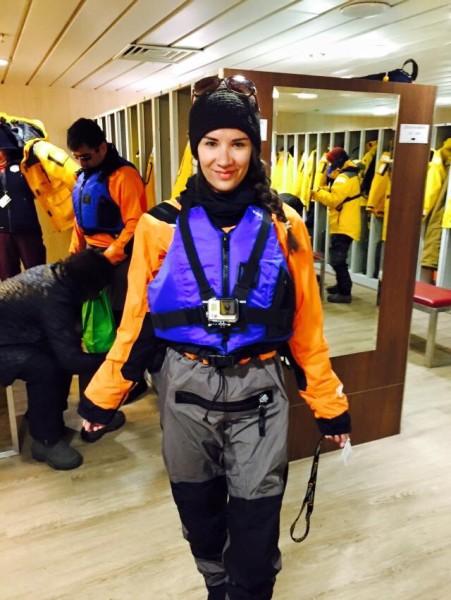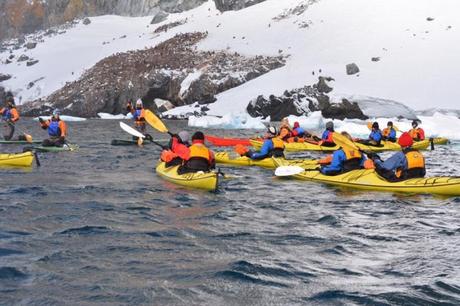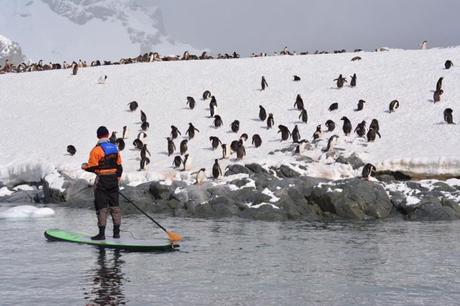I can now proudly say I'm one of the first people in the world to have SUP'ed in Antarctica. And no, I didn't fall off my board into the frigid waters, despite some dire predictions among my family and friends.
To be honest, I chose my ship almost solely based on the fact they're the only ones who currently offer stand up paddleboarding as one of the adventure activities. I promised myself I'd practice the sport before I got down south and then promptly avoided it for my entire journey throughout South America. Thus, I found myself checking in about a dozen times with the safety zodiac driver that he would be able to fish me out quickly when I fell in.
Conditions for SUP in Antarctica Must be Perfect

SUP in Antarctica is incredibly difficult. Though I had signed up a year in advance, we had been warned plenty that there were no guarantees we would get out even once during the voyage. We spent the two days crossing the Drake getting fitted for dry suits and discussing the logistics of SUP. With five days in Antarctica, we had a potential of ten possible excursions. We were the smallest group on the ship in adventure activities, with only twelve people enrolled, further split into two groups. My group was up first.
Conditions for SUP have to be incredibly perfect. The water has to be placid, the wind has to be nearly nonexistent, and we have to have a good forecast. Several times we were called to suit up, only to be canceled at the last moment when the winds dramatically changed from 0 mph to 30mph. While I began to worry we wouldn't ever get our chance, I also wasn't keen about getting stuck in a blizzard while on a tiny paddleboard in a hostile environment.
Finally, on the third day, we got the most perfect conditions imaginable.
Colliding with Icebergs and Then Some

We suited up in neon dry suits, scuba boots and a life jacket before setting off in the cold air in a zodiac cruiser. The skies were beautifully clear and the mood jubilant. We were fitted for our paddles on board, given a quick demonstration on both how to mount our board and effectively stand up, and then we were off. I found myself sitting on the edge of a perfectly good boat staring dubiously at the paddleboard as it swayed in the water. I tethered myself to it and fell awkwardly onto it on my hands and knees. It wobbled a bit but remained balanced. I pushed myself onto just my knees and attempted to paddle. So far so good.
Getting to my feet was surprisingly easy for how much I psyched myself up. We were counseled to look forward and not down, or we'd fall into the water. Then we kind of reverse squatted our way up and tried to paddle immediately. I made it to my feet without issue and paddled aimlessly in a circle until the guide explained how to change positions.

Paddleboarding in Antarctica presented both amusements and challenges. We paddled our way around sea ice and icebergs. Occasionally the safety driver would yell out my name and I'd have to fall to my knees quickly as I collided with an iceberg. Half the time we were too busy looking at the gorgeous scenery that we would collapse onto our boards at the last minute as we collided with one another. I spent a good deal of time getting back up, relishing at the ease of the board.

Eventually I heard a splash as one of the paddleboarders fell into the freezing sea.
I secretly high fived my guide that it wasn't me and continued to paddle past an iceberg.

Paddleboarding in Antarctica was an amazing experience; while I'm sure I'll give the sport another go somewhere perhaps a bit warmer, I don't think I will ever top my first experience. Paddling idly by as a colony of penguins watches you curiously from shore before diving en masse into the water to frolic around your board; bumping almost playfully into thousand year old ice; disturbing a grumpy looking seal accidentally from his lazy nap.
These are the moments that can't be repeated anywhere else in the world.
